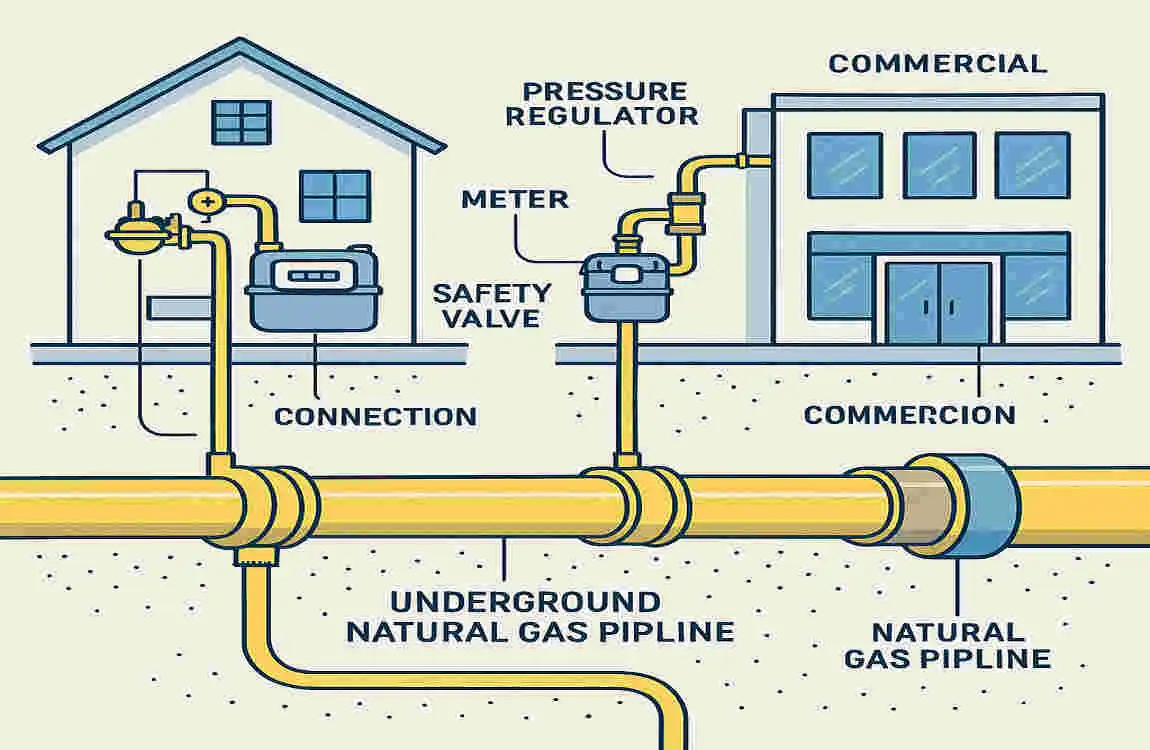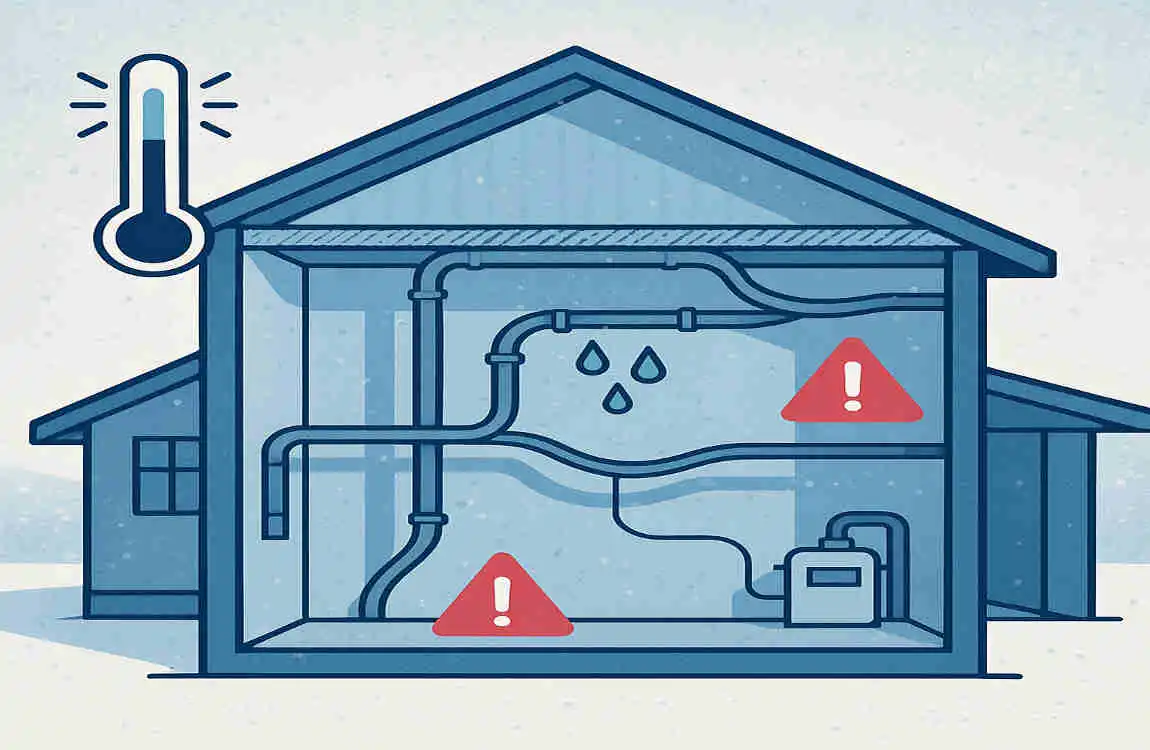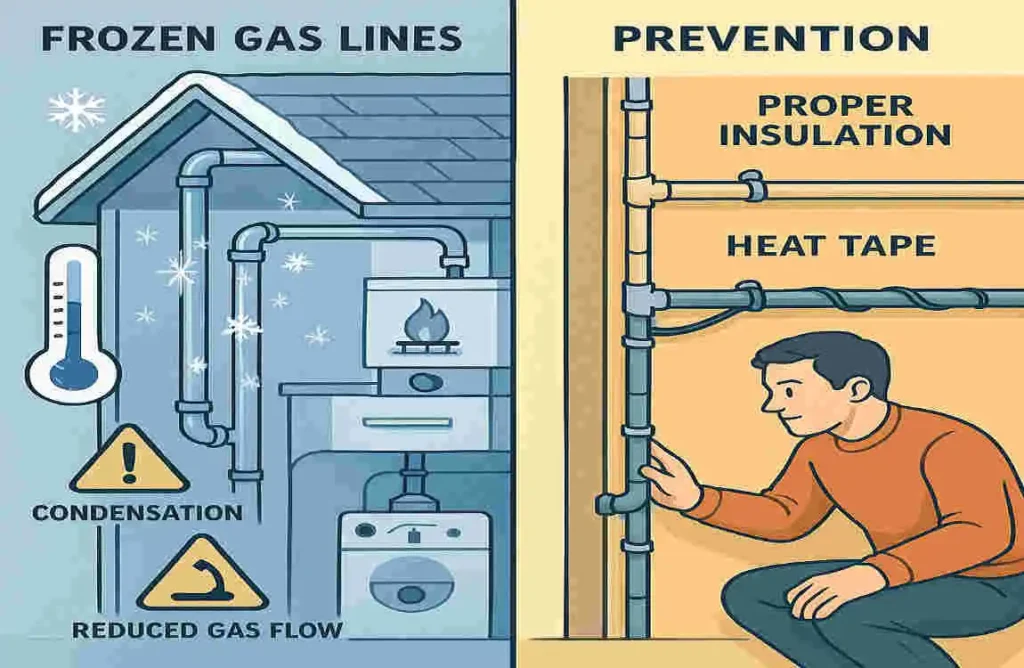Gas lines play a crucial role in keeping our homes warm and our appliances running smoothly. From heating our living spaces to powering our stoves and water heaters, natural gas and propane are essential for our daily comfort and convenience. Have you ever wondered if these gas lines in your house can freeze? Understanding the risks of freezing gas lines is vital for every homeowner’s safety and peace of mind.
We’ll discuss the risks and dangers associated with frozen gas lines, the warning signs you should watch out for, and, most importantly, how you can take proactive steps to prevent this issue in your own home. So, let’s get started and ensure your gas lines stay safe and functional, even in the coldest winter months.
What Are Gas Lines and How Do They Work?

Before we delve into the freezing risks, let’s take a moment to understand what gas lines are and how they function in our homes.
Definition and Purpose of Gas Lines
Gas lines are the network of pipes that deliver natural gas or propane from the main supply line to various appliances throughout your home. These lines are responsible for safely transporting the gas to your furnace, water heater, stove, and other gas-powered devices.
Types of Gases Commonly Used
In residential settings, the two most common types of gases used are natural gas and propane. Natural gas is often supplied by utility companies through underground pipelines, while propane is typically stored in tanks on the property and delivered by a propane supplier.
How Gas Flows Through Pipes to Appliances
Gas flows through the pipes due to pressure differences between the main supply line and the appliances. The gas enters your home at a higher pressure and is then regulated to a lower pressure suitable for your appliances. This pressure difference creates a steady flow of gas through the pipes, ensuring a reliable supply to your heating and cooking needs.
Typical Pipe Materials and Insulation Considerations
Gas lines are typically made from materials such as steel, copper, or plastic (e.g., polyethene). The choice of material depends on factors like cost, durability, and local building codes. Insulation is crucial for maintaining the temperature of the gas and preventing condensation within the pipes, especially in colder climates or unheated areas of the home.
Can Gas Lines Actually Freeze in a House?
Now, let’s address the burning question: can gas lines actually freeze in a house? The short answer is yes, but it’s not as simple as the gas itself freezing.
Under What Conditions Can Gas Lines Freeze
Gas lines can freeze under certain conditions, primarily when moisture or condensation within the pipes reaches freezing temperatures. While the gas itself rarely freezes, the presence of water vapour in the lines can lead to ice formation and blockages.
Scientific Explanation of Freezing Gas Lines
The freezing point of natural gas is around -297°F (-183°C), which is far below the temperatures experienced in most homes. Propane has a slightly higher freezing point of -188 °C (-306°F). However, it’s not the gas itself that freezes; it’s the moisture within the lines that can turn into ice and cause problems.
Role of Moisture in Causing Blockages or Ice Formation
When warm, moist air comes into contact with cold gas lines, condensation can occur. If the temperature drops below freezing, this condensation can freeze, potentially blocking the flow of gas through the pipes. This is why gas lines in unheated or poorly insulated areas of the home are more susceptible to freezing.
Situations Where Indoor Gas Lines Are More Vulnerable
Indoor gas lines are more likely to freeze in areas such as basements, crawlspaces, or exterior walls, where temperatures can drop significantly lower than those in the rest of the house. Unused rooms or unheated spaces, such as garages or sheds, can also pose a higher risk for freezing gas lines.
Climate Impact: Extreme Cold Weather and Poorly Heated Spaces
Extreme cold weather can increase the likelihood of gas lines freezing, especially in regions that experience prolonged periods of sub-zero temperatures. Poorly heated spaces within the home, such as unfinished basements or attics, can also contribute to the risk of freezing gas lines.
Risks and Dangers of Frozen Gas Lines
Frozen gas lines can pose significant risks and dangers to your home and family. Let’s explore some of the potential hazards associated with this issue.
Potential Hazards Caused by Frozen or Blocked Gas Lines
When gas lines freeze or become blocked, it can lead to a range of problems, from minor inconveniences to serious safety concerns.
Gas Flow Interruption Leading to Appliance Malfunctions
One of the most immediate effects of frozen gas lines is the interruption of gas flow to your appliances. This can cause your furnace, water heater, or stove to malfunction or stop working altogether, leaving you without heat or the ability to cook.
Risk of Gas Leaks Due to Pressure Buildup or Pipe Damage
When gas lines are blocked or frozen, pressure can build up within the pipes. This increased pressure can lead to leaks or even pipe damage, creating a dangerous situation in your home. Gas leaks can be difficult to detect and pose a significant risk of fire or explosion.
Safety Concerns: Carbon Monoxide Buildup, Fire Risks
Frozen gas lines can also contribute to the buildup of carbon monoxide, a colourless and odourless gas that can be deadly in high concentrations. If your gas appliances are not functioning properly due to frozen lines, they may produce more carbon monoxide than usual, putting your family at risk.
Additionally, the risk of fire increases when gas lines are compromised. A gas leak caused by frozen or damaged pipes can ignite if it comes into contact with an open flame or electrical spark, leading to a potentially devastating fire in your home.
Why Frozen Gas Lines Are a Serious Home Safety Issue
As you can see, frozen gas lines are not just an inconvenience; they are a serious home safety issue that every homeowner should be aware of. Taking proactive steps to prevent freezing and addressing any problems promptly can help protect your family and your property from the dangers associated with this problem.
Common Signs & Symptoms of Frozen Gas Lines
Recognising the signs and symptoms of frozen gas lines is crucial for addressing the issue before it becomes a major problem. Let’s explore some of the most common indicators that your gas lines may be frozen.
Difficulty Lighting Gas Appliances
If you’re having trouble lighting your gas stove, furnace, or fireplace, it could be a sign that your gas lines are frozen. The reduced gas flow caused by ice blockages can make it challenging to ignite your appliances.
Reduced Gas Flow or Uneven Flame
Another telltale sign of frozen gas lines is a reduced gas flow or an uneven flame on your appliances. If you notice that your stove burners are not burning as brightly as usual or that your furnace is struggling to maintain a consistent temperature, it may be due to frozen gas lines.
Strange Noises from Gas Appliances
Frozen gas lines can sometimes cause strange noises to emanate from your gas appliances. You may hear hissing, whistling, or gurgling sounds as the gas struggles to flow through the partially blocked pipes.
Inconsistent Heating or Appliance Failure
If your furnace or water heater is not heating consistently or is not working at all, frozen gas lines may be the culprit. The reduced gas flow can cause these appliances to malfunction, leaving you without heat or hot water.
How to Safely Check Your Gas Lines for Freezing or Blockages
If you suspect that your gas lines may be frozen, it’s important to check them safely. Here are some steps you can take:
- Turn off the gas supply: Locate your main gas shut-off valve and turn it to the “off” position to prevent any potential gas leaks.
- Check for visible ice or frost: Inspect the exposed sections of your gas lines for any signs of ice or frost buildup.
- Feel for cold spots: Run your hand along the gas lines to feel for any unusually cold spots, which could indicate freezing.
- Listen for unusual sounds: Pay attention to any strange noises coming from your gas appliances or pipes.
If you notice any of these signs, it’s crucial to contact a professional immediately to assess and address the issue.
Factors That Increase the Risk of Gas Line Freezing

Several factors can increase the risk of gas line freezing in your home. Understanding these factors can help you take proactive steps to minimise the chances of this issue occurring.
Poor Insulation in Basements, Crawlspaces, or Exterior Walls
One of the primary risk factors for frozen gas lines is inadequate insulation in areas such as basements, crawl spaces, or exterior walls. These areas are more likely to experience lower temperatures, increasing the likelihood of freezing.
Low Indoor Temperatures in Unused Rooms or Unheated Areas
Maintaining a consistently warm home temperature can help prevent gas lines from freezing. However, if you have unused rooms or unheated areas in your home, the lower temperatures in these spaces can increase the risk of frozen gas lines.
High Humidity Levels Inside the Walls or Crawl Spaces
High humidity levels within your home’s walls or crawl spaces can contribute to condensation and moisture buildup in your gas lines. This excess moisture can then freeze and cause blockages when temperatures drop.
Older or Damaged Gas Piping
Older or damaged gas piping is more susceptible to freezing. Over time, pipes can develop cracks, corrosion, or other forms of damage, making them more vulnerable to ice formation and blockages.
Prolonged Exposure to Freezing Outdoor Temperatures
If your home is located in an area that experiences prolonged periods of freezing outdoor temperatures, the risk of gas line freezing increases. The colder it is outside, the more likely it is for the temperature inside your home to drop, especially in unheated or poorly insulated areas.
How to Prevent Gas Lines from Freezing in Your Home
Now that we’ve explored the risks and factors associated with frozen gas lines, let’s discuss some practical steps you can take to prevent this issue in your own home.
Insulation Tips: Pipe Wraps, Foam Insulation, Heat Tape
One of the most effective ways to prevent gas lines from freezing is to ensure they are properly insulated. Here are some insulation options you can consider:
- Pipe wraps: These are flexible, foam-based wraps that can be easily applied to your gas lines. They provide an extra layer of insulation to keep the pipes warm.
- Foam insulation: Foam insulation sleeves can be slipped over your gas lines to provide additional protection against cold temperatures.
- Heat tape: Electric heat tape can be wrapped around your gas lines to provide a constant source of heat, preventing freezing even in the coldest conditions.
Maintaining a Steady Indoor Temperature, Especially in Vulnerable Areas
Maintaining a steady indoor temperature is crucial for preventing gas lines from freezing. Keep your thermostat set to a consistent temperature, even when you’re away from home. Pay special attention to vulnerable areas, such as basements, crawlspaces, and unused rooms, to ensure they remain warm enough to prevent freezing.
Sealing Gaps and Air Leaks to Prevent Cold Drafts Near Gas Pipes
Cold drafts near your gas pipes can increase the risk of freezing. Take the time to seal any gaps or air leaks in your home, especially around areas where your gas lines run. Use weatherstripping, caulk, or foam sealant to close up these openings and keep cold air out.
Using a Space Heater Safely in Basement or Crawl Spaces
If you have a basement or crawl space that is particularly susceptible to freezing, consider using a space heater to keep the area warm and prevent freezing. However, it’s crucial to use space heaters safely. Choose a heater with safety features like tip-over protection and automatic shut-off, and never leave it unattended or use it near flammable materials.
Routine Maintenance: Inspecting Pipes, Clearing Moisture, Checking for Damage
Regular maintenance is key to preventing gas line freezing. Make it a habit to inspect your gas lines periodically, looking for any signs of damage, corrosion, or moisture buildup. If you notice any issues, address them promptly to prevent further problems from arising.
Professional Inspection and Winterising Services
For added peace of mind, consider scheduling a professional inspection of your gas lines, especially before the winter months. A licensed technician can assess your system, identify any potential issues, and recommend any necessary repairs or winterising services to keep your gas lines safe and functional.
Smart Home Technology to Monitor Indoor Temperature and Gas Flow
Smart home technology can be a valuable tool in preventing gas line freezing. Consider investing in a smart thermostat that can monitor your indoor temperature and alert you if it drops below a certain threshold. Some smart home systems can also monitor your gas flow and notify you of any irregularities, helping you catch potential issues before they become major problems.
What To Do If You Suspect Frozen Gas Lines
If you suspect that your gas lines are frozen, it’s essential to take immediate action to ensure your safety and prevent further damage. Here’s what you should do:
Immediate Safety Steps: Turning Off the Gas Supply
The first step is to turn off your gas supply. Locate your main gas shut-off valve and turn it to the “off” position. This will help prevent any potential gas leaks and minimise the risk of fire or explosion.
Avoiding Use of Open Flames or Electrical Appliances
When dealing with suspected frozen gas lines, it’s crucial to avoid using any open flames or electrical appliances near the affected area. These can ignite any leaked gas, causing a dangerous situation.
Contacting Your Gas Company or a Licensed Professional
Once you’ve taken the necessary safety precautions, contact your gas company or a licensed professional immediately. They have the expertise and equipment to safely assess and address the issue, ensuring your gas lines are thawed and functioning properly.
Do Not Try to Thaw Frozen Pipes with Open Flame or Unsafe Methods
It may be tempting to try to thaw frozen gas lines yourself, but this is extremely dangerous and should never be attempted. Using an open flame or other unsafe methods can lead to gas leaks, fires, or explosions. Always leave the thawing and repair of frozen gas lines to the professionals.
Myths and Misconceptions About Freezing Gas Lines
There are several myths and misconceptions surrounding freezing gas lines that can lead to confusion and potentially dangerous situations. Let’s clear up some of the most common misunderstandings:
Clearing Up Common Misunderstandings
- Myth: Gas itself can freeze in the lines. Reality: While the gas itself rarely freezes, it’s the moisture within the lines that can turn into ice and cause blockages.
- Myth: Indoor gas lines never freeze. Reality: Indoor gas lines can freeze, especially in unheated or poorly insulated areas of the home.
- Myth: Frozen gas lines are just an inconvenience. Reality: Frozen gas lines can pose serious safety risks, including gas leaks, carbon monoxide buildup, and fire hazards.
Why Gas Itself Doesn’t Freeze, But Moisture Causes Issues
As we mentioned earlier, the freezing point of natural gas and propane is far below the temperatures experienced in most homes. However, the presence of moisture within the gas lines can lead to ice formation and blockages when temperatures drop below freezing.
Difference Between Outdoor and Indoor Pipe Freezing Risks
While outdoor gas lines are more susceptible to freezing due to exposure to cold temperatures, indoor gas lines can also freeze, especially in unheated or poorly insulated areas. It’s important to take precautions to protect both indoor and outdoor gas lines from freezing.
Importance of Professional Advice for Gas System Problems
When it comes to your gas system, it’s always best to seek professional advice. Gas lines and appliances are complex systems that require specialised knowledge and equipment to maintain and repair safely. Don’t hesitate to contact your gas company or a licensed professional if you have any concerns or issues with your gas lines.
